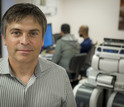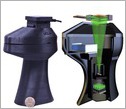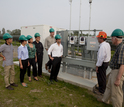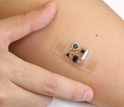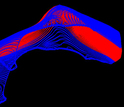News Release 15-106
NSF invests $10 million in smart, human-centered service systems
Awards to spur innovation for smart health, manufacturing and infrastructure
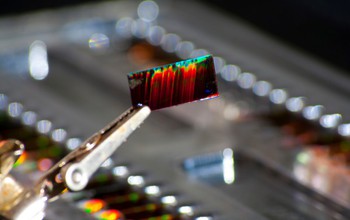
Photonic crystals will enable a smartphone-based system to detect and track infectious diseases.
September 14, 2015
This material is available primarily for archival purposes. Telephone numbers or other contact information may be out of date; please see current contact information at media contacts.
From transportation to healthcare, service systems make our lives easier and more productive on a daily basis.
New technologies that learn from data are bringing intelligence to service systems, allowing them to center on people by incorporating individuals' feedback and input. These systems create more value through adaptive and individualized interactions. The National Science Foundation (NSF) has invested $10 million in such systems, supporting innovative new partnership projects to create service systems that are smart and human-centric.
The interdisciplinary projects will engage academia and the private sector in highly interactive collaborations. Partners will advance, adapt and integrate novel smart technologies for service systems in ways that dramatically improve performance.
"Smart, human-centered service systems offer unprecedented new economic opportunities and societal benefits, whether to an individual seeking personalized medical care or to a utility company managing energy demands," said Pramod Khargonekar, NSF assistant director for Engineering. "Bringing new technologies, and new system design thinking and human factors together can lead to services we are just beginning to imagine."
Several of these three-year, $1 million projects tie into NSF's investments in smart, connected communities, whether through energy, healthcare, environmental or other services.
"Partnerships between academia and industry supported through these projects can help to translate innovative research and emerging technologies into smart service systems, which will help to enable smart and connected communities of the future," said Jim Kurose, NSF assistant director for NSF's Directorate for Computer and Information Science and Engineering.
Smart service systems utilize data to learn and adapt, and to facilitate decision-making in order to improve how they respond to future situations. Such systems may recognize patterns and preferences to improve performance.
These adaptive capabilities are made possible thanks to emerging technologies for sensing, coordination, communication, control and other purposes. New detection, classification and localization technologies also help make service systems smarter.
By definition, a human-centered service system interacts with people--end users, recipients, beneficiaries, providers and/or decision makers--as it operates. These interactions must add value to people to be considered a service.
This year, NSF funded 10 Partnerships for Innovation: Building Innovation Capacity (PFI:BIC) projects for smart, human-centered service systems:
- A smart service system (ESPnet) for enhanced monitoring and management of toxic algal blooms: Donald Anderson of the Woods Hole Oceanographic Institution, principal investigator.
- Pathtracker: A smartphone-based system for mobile infectious disease detection and epidemiology: Brian Cunningham of the University of Illinois at Urbana-Champaign, principal investigator.
- A smart, always-on health monitoring system: YongGang Huang of Northwestern University, principal investigator.
- Smart CROwdsourced Urban Delivery (CROUD) system: Yu Nie of Northwestern University, principal investigator.
- Developing advanced resilient microgrid technology to improve disaster response capability: Thomas Ortmeyer of Clarkson University, principal investigator.
- Human-centered smart-integration of mobile imaging and sensing tools with machine learning for ubiquitous quantification of waterborne and airborne nanoparticles: Aydogan Ozcan of the University of California, Los Angeles, principal investigator.
- Adaptive robotic nursing assistants for physical tasks in hospital environments: Dan Popa of the University of Texas at Arlington, principal investigator.
- Utility-driven smart energy services: Prashant Shenoy of the University of Massachusetts, Amherst, principal investigator.
- Cyber-physical service system for 3-D printing of adaptive custom orthoses: Albert Shih of the University of Michigan, principal investigator.
- A cost-effective accurate and resilient indoor positioning system: Bruno Sinopoli of Carnegie Mellon University, principal investigator.
NSF's fiscal year 2015 investment in PFI:BIC is a collaboration among the directorates for Engineering (ENG), Computer and Information Science and Engineering (CISE), and Geosciences. In fiscal year 2014, ENG and CISE funded 11 PFI:BIC projects for smart service systems.
-NSF-
-
Robots can learn to help both nurses and patients.
Credit and Larger Version -
Mobile imaging and sensing tools will measure nanoparticles in air and water.
Credit and Larger Version -
Advanced, resilient microgrid technology will improve disaster response capability.
Credit and Larger Version -
A non-invasive health-monitoring system will seamlessly integrate with people's lives.
Credit and Larger Version -
Internet-based design and rapid manufacturing will help make customized orthotic devices possible.
Credit and Larger Version
Media Contacts
Sarah Bates, NSF, (703) 292-7738, email: sabates@nsf.gov
Program Contacts
Sara B. Nerlove, NSF, (703) 292-7077, email: snerlove@nsf.gov
Related Websites
FY 2015 Partnerships for Innovation: Building Innovation Capacity (PFI:BIC) solicitation: http://www.nsf.gov/funding/pgm_summ.jsp?pims_id=504708
The U.S. National Science Foundation propels the nation forward by advancing fundamental research in all fields of science and engineering. NSF supports research and people by providing facilities, instruments and funding to support their ingenuity and sustain the U.S. as a global leader in research and innovation. With a fiscal year 2023 budget of $9.5 billion, NSF funds reach all 50 states through grants to nearly 2,000 colleges, universities and institutions. Each year, NSF receives more than 40,000 competitive proposals and makes about 11,000 new awards. Those awards include support for cooperative research with industry, Arctic and Antarctic research and operations, and U.S. participation in international scientific efforts.
Connect with us online
NSF website: nsf.gov
NSF News: nsf.gov/news
For News Media: nsf.gov/news/newsroom
Statistics: nsf.gov/statistics/
Awards database: nsf.gov/awardsearch/
Follow us on social
Twitter: twitter.com/NSF
Facebook: facebook.com/US.NSF
Instagram: instagram.com/nsfgov



